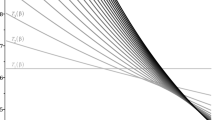Abstract
We present a new, fully anisotropic, criterion for formation of trapped surfaces in vacuum. More precisely we provide local conditions on null data, concentrated in a neighborhood of a short null geodesic segment (possibly flat in all other directions) whose future development contains a trapped surface. This extends considerably the previous result of Christodoulou (Monographs in Mathematics. European Mathematical Society, Switzerland, 2009) which required instead a uniform condition along all null geodesic generators. To obtain our result we combine Christodoulou’s mechanism for the formation of a trapped surface with a new deformation process which takes place along incoming null hypersurfaces.

Similar content being viewed by others
Notes
The result of Penrose applies in fact to the more general Einstein-matter equations satisfying the null energy condition, but we restrict our considerations here to the vacuum case.
Smooth and free of trapped surfaces.
On the outgoing null hypersurface. The incoming data is flat.
Such that the initial configuration is given by the incoming \(\{{\underline{u}}=0\}\) and outgoing \(\{u=0\}\) initial null hypersurfaces.
These can be compared to the optical functions \(u=\frac{t-r+1}{2}\), \({\underline{u}}=\frac{t+r-1}{2}\) in Minkowski spacetime.
General values for \(r(0,0)\) can be recovered from this special case via a simple rescaling argument.
see for example Lemma 3.1.3 in [3].
Here, \(\in _{ab}\) denotes the area 2-form and \(\mathrm{div}\) the divergence operator on the sphere \(S_{u,{\underline{u}}}\). We refer the readers to [4] for the precise definitions of all of the notations below.
Strictly speaking, the original theorem of Christodoulou is stated somewhat differently. The version we use here is a straightforward reformulation of his results in [2] by a simple rescaling.
In other words \(M_0[\hat{\chi }](\omega )= M_0[\hat{\chi }'](\omega ) =\int _{f(0,\omega )}^{f(\delta ,\omega )} |\hat{\chi }'({\underline{u}}',\omega )|^2 d{\underline{u}}'\) where \(\hat{\chi }'_{ab}=\frac{1}{2} g(D_{e_a} \frac{\partial }{\partial {\underline{u}}'}, e_b)\) for a new foliation \({\underline{u}}'=f({\underline{u}},\omega )\), with \(\frac{\partial f}{\partial {\underline{u}}}> 0\).
Here \(\Delta _0\) and \(\nabla _0\) are defined with respect to the connection on the initial sphere \(S_{0,0}\).
The operator \(\widehat{\otimes }\) refers to the traceless part of the symmetrized tensor product. We refer the readers to [4] for the precise notations used in this paper.
Here, \(\frac{\partial }{\partial {\underline{u}}}\) and \(\frac{\partial }{\partial u}\) refers to the coordinate vector fields defined with respect to a coordinate system \((u,{\underline{u}},\theta ^1,\theta ^2)\), where \(\theta ^1\) and \(\theta ^2\) satisfy the conditions (18) and (19). Notice that this is different from the vector fields \(\Omega e_4\) and \(\Omega e_3\) as \(\Omega e_4\) would have an “angular component” in the coordinate system \((u,{\underline{u}},\theta ^1,\theta ^2)\). In particular, \(\frac{\partial }{\partial {\underline{u}}}\) is not parallel to the null generators. Nevertheless, as a consequence of the assumptions MA1–MA4, the difference between \(\frac{\partial }{\partial {\underline{u}}}\) and \(\Omega e_4\) is a vector field on \(TS_{u,{\underline{u}}}\) with a small norm and will be collected in the error terms in the equations.
Recall that \(\nabla R\) is defined with respect to the connection coefficients of the spheres adapted to the \((u,{\underline{u}})\) foliation at the set \(\{({\underline{u}},u,\omega ): {\underline{u}}=\delta , 1-u=R(\omega )\}\); while \(\nabla _0 R\) is defined with respect to the connection coefficients on the initial sphere \(S_{0,0}\).
We thank Demetrios Christodoulou for pointing out a related idea.
Assuming \(\delta \delta _0^{-1}\), \(\delta _0\) sufficiently small, depending on \(M_0\).
From this point onwards, we drop the subscript \(_0\) in the connection coefficients as it will be clear from context that we consider the connection coefficients associated to the initial sphere \(S_{0,0}\).
Note in particular the logarithmic cancellation in the formulas for \(\nabla \tilde{w}_\epsilon \) and \(\nabla ^2 \tilde{w}_\epsilon \).
References
Aubin, T.: Non-Linear Analysis on Manifolds. Monge–Ampère Equations. Springer, Berlin (1982)
Christodoulou, D.: The formation of black holes in general relativity. In: Monographs in Mathematics. European Mathematical Society, Switzerland (2009)
Klainerman, S., Nicoló, F.: The evolution problem in general relativity. in: Progress in Mathematical Physics, vol. 25. Birkhäuser, Boston (2003). ISBN 0-8176-4254-4
Klainerman, S., Rodnianski, I.: On the formation of trapped surfaces. Acta Mathematica 208, 211–333 (2012)
Klainerman, S., Rodnianski, I.: On emerging of scarred surfaces for the Einstein vacuum equations. Discrete Contin. Dyn. Syst. 28(3), 1007–1031 (2010)
Luk, J., Rodnianski, I.: Nonlinear interaction of impulsive gravitational waves for the vacuum Einstein equations. (2012, preprint). arXiv:1301.1072
Reiterer, M., Trubowitz, E.: Strongly focused gravitational waves. Comm. Math. Phys. 307, 275–313 (2011)
Acknowledgments
We would like to thank Demetrios Christodoulou for his helpful suggestions on a previous version of the manuscript. We would also like to thank Pin Yu, Ovidiu Savin and Stefanos Aretakis for helpful remarks and useful discussions. S. Klainerman would like to thank the Fondation SMP for the support of this work. S. Klainerman is supported by the NSF Grant DMS-0901250. J. Luk is supported by the NSF Postdoctoral Fellowship DMS-1204493. I. Rodnianski is supported by the NSF Grant DMS-1001500. S. Klainerman and I. Rodnianski are also supported by the FRG Grant DMS-1065710.
Author information
Authors and Affiliations
Corresponding author
Rights and permissions
About this article
Cite this article
Klainerman, S., Luk, J. & Rodnianski, I. A fully anisotropic mechanism for formation of trapped surfaces in vacuum. Invent. math. 198, 1–26 (2014). https://doi.org/10.1007/s00222-013-0496-6
Received:
Accepted:
Published:
Issue Date:
DOI: https://doi.org/10.1007/s00222-013-0496-6




